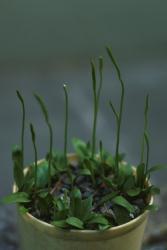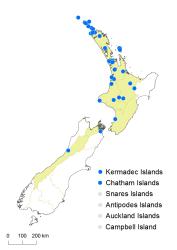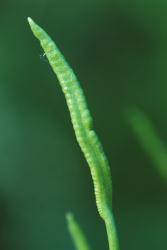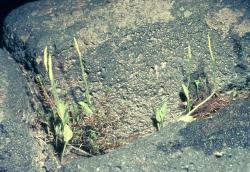- Taxon
- Gallery
- = Ophioglossum elongatum R.Cunn. ex A.Cunn., Companion Bot. Mag. 2: 361 (1837)
Rhizomes erect, subterranean, 3–20 mm long, glabrous; roots fleshy, horizontal ones producing vegetative buds. Fronds 70–345 mm long, divided into a sterile lamina and fertile sporophore. Stipes 27–185 mm long, yellow-brown or green distally, glabrous or with very occasional hairs. Sterile laminae (on fertile fronds) undivided, ovate or rarely elliptic, 11–115 mm long, 8–37 mm wide, rarely only 5 mm wide; apex acute to obtuse or rarely rounded; margins entire; base occasionally cuneate and sessile or often abruptly narrowed to an indistinct stalk; both surfaces yellow-green; fleshy or herbaceous; glabrous or with very occasional hairs. Veins usually distinct. Sporophore held above the sterile lamina, borne on a stalk 24–185 mm long, entire, linear, 14–55 mm long, rarely only 10 mm long, 2–3.5 mm wide, fleshy, glabrous. Sporangia in 17–48 pairs, rarely only 13 pairs, deeply sunken in two rows either side of the sporophore.
Ophioglossum petiolatum is a rare fern in New Zealand. It is distinguished from O. coriaceum by its broader sterile blade (rarely less than 8 mm wide) which has a cuneate or truncate base, and often has distinct veins; the length:width ratio is almost always less than 3:1. The sporophore is generally longer (10–55 mm long) and has more sporangia (rarely less than 17 pairs). By contrast, O. coriaceum has a generally narrower sterile blade (rarely more than 14 mm wide) that tapers to an attenuate or acuminate base and often has indistinct veins. The sporophore is shorter (3–21 mm long) and has fewer sporangia (rarely more than 17 pairs).
Ophioglossum petiolatum is variable in size and leaf shape. Larger plants are readily distinguishable from O. coriaceum by their broader sterile laminae with truncate bases, but small plants and stunted forms from thermal sites overlap significantly in their range of variation. In particular, plants from Scott Point, near Cape Maria van Diemen, have short fertile spikes even on bigger plants, and some are very stunted, resembling O. coriaceum. No true O. coriaceum has been recorded from this locality.
North Island: Northland, Auckland, Volcanic Plateau, Taranaki, Southern North Island.
South Island: Sounds-Nelson, Westland.
Kermadec Islands, Three Kings Islands, Chatham Islands.
Altitudinal range: 0–380 m.
Ophioglossum petiolatum has been recorded throughout much of the western part of the North Island from Te Paki to near Levin, but populations are small and widely distributed, and some are no longer extant. It has been collected only in lowland areas, mostly from near sea level, but up to 380 m in the Waitakere Ranges, Auckland. Only two collections have been made in the South Island, both from lowland sites, but it has not been seen there for over 90 years. It is also known from the Kermadec, Three Kings and Chatham Islands. Its limited distribution in New Zealand has been documented by Brownsey (1985) and de Lange et al. (2010), the latter indicating that it was then known from only 11 northern North Island sites.
Also widely distributed in the tropics and subtropics of Central and South America, and in the Old World tropics from Africa to India, Asia and Australia (Western Australia, Northern Territory, Queensland, New South Wales, Victoria). In the Pacific it has been recorded from New Caledonia, Fiji, Niue, the Society Islands and Hawai‘i, but is poorly distinguished from O. reticulatum and may be more widespread.
Occurs in the open, in open bush, or under kānuka or podocarp forest, usually on the margins of swamps, lakes, ponds and streams, in alluvial soils and damp hollows, amongst Dacrycarpus dacrydioides roots, in short grassland or on thermally heated soil. The plant dies down completely in winter, emerging again in spring from the underground rhizome.
Ophioglossum petiolatum was given a conservation status of Nationally Critical by de Lange et al. (2013).
No accurate chromosome count has been obtained for Ophioglossum petiolatum, but Brownsey in Dawson et al. (2000) and de Lange et al. (2004) both recorded irregular pairing at meiosis.
Many earlier authors referred this species in New Zealand to O. pedunculosum Desv. or Ophioglossum vulgatum var. pedunculosum (Desv.) Domin, but the nomenclatural confusion surrounding the use of these names has been resolved by Clausen (1938b, 1938a) and the implications for New Zealand plants explained in detail by Brownsey et al. (1985). The names O. vulgatum L., O. costatum R.Br. and O. vulgatum var. costatum (R.Br.) Hook.f. have also been used incorrectly for O. petiolatum, or erroneously recorded for New Zealand.
Clausen (1938b, 1938a) referred the New Zealand plant to O. petiolatum. He distinguished it from the closely related O. reticulatum L. by its "lance-ovate blade, which is acute at the apex, by the rather long, slender fertile segment, and by the lax venation", but conceded that the two intergraded in India, China and Mexico. Wieffering (1964) went further and reduced O. petiolatum to synonymy with O. reticulatum, although admitting that it was "highly polymorphous" with chromosome numbers ranging from n = 120 to c. 630. The name O. reticulatum has been used for Australian material (Chinnock 1998). However, in the absence of any conclusive evidence, Brownsey et al. (1985) followed Brownlie (1969, 1977) in recognising the species in the Pacific as O. petiolatum, a precedent which is followed here in the interests of consistency and stability.







